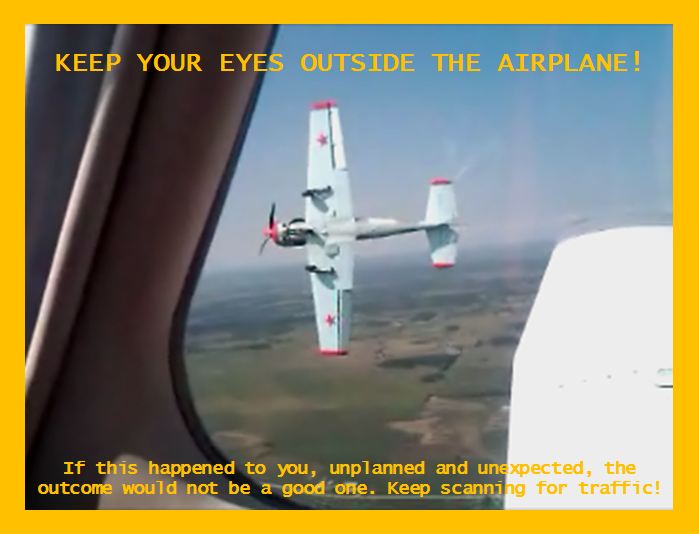You as a pilot are responsible for collision avoidance. That means, in order to avoid a collision you have to be looking outside the plane! I see so many students and pilots both staring at the instruments instead of looking outside. I will remind them to look outside and for a brief few seconds they look up and around and then fall right back into their instrument panel coma.
This habit has to be broken or it will continue until you aren’t so lucky anymore.. There are many things that keep pilots from looking outside, such as trying to learn something inside the plane, distraction from passengers or even your new aviation toy. You need to learn to multi-task. I’ve asked pilots to turn to a certain heading, just to have them roll into a turn without ever even looking where they are going.
The average general aviation airplane used for training goes around 120 mph. If cars were driving down the street at 120 mph, and you were a passenger, how would you feel if the driver kept pulling out into the street without looking before he turned? The longer your head is down, not looking out, the more you risk death.
Keep scanning for other planes and don’t stop. If you see one out in the distance and it doesn’t seem to be moving, you are probably on a collision course. If you are heading towards each other and both going the same speed, you are closing in on each other at a speed of almost 250 miles per hour! In just a few seconds, you’d be right on top of each other and you wouldn’t have enough time to react. At least if you see it, you can divert your course to avoid a collision.
Whenever I see my students staring inside (which is usually while doing take off and landing practice), I cover up the instruments. I cover all of them. They usually ask how they are supposed to know their speed. I tell them that if they put the plane in the position it normally is for landing, then the speed will fall into place. You don’t need to stare at the airspeed because if you’re holding the plane stable, the speed will stay stable too. If you’re raising the nose, the speed will slow down. If your letting the nose drop, it will speed up. Look at the horizon and you can see it. You can also hear the engine changing.
When it comes time to take off, they worry because they don’t want to rotate too soon or climb out to slow. I tell them that we’ve done it enough times to know what it should look like, feel like and sound like. When you think we are at rotate speed, then rotate. Put your nose in the climb attitude during the climb that we always use and things will be fine. I also tell them to level off when they think we are at pattern altitude. Yes, the altimeter is covered too.
During climbout I will pop off the airspeed cover for a second just to show them that the speed is just fine. Every single time, it has been within 5-7 knots which is within PTS standards. They usually ask again, when to level off. I remind them to do it when they think we are at pattern altitude. After leveling off, I again show them and most of the time, the altitude is within 100′. Only one time was someone off more than that and they were only 200′ off. They did just fine without having any visual reference to any of the instruments. It just proves that you know the plane better than you think you do! We continue several circuits in the pattern like this before I pull off the covers. I say, now that you know you can fly without looking inside at all, keep your eyes outside! They are always amazed at how close they were on speed and altitude.
You need to know your plane well. Focus your attention on how the plane sounds, what it looks like outside while you are doing different maneuvers, etc. You need to realize that you know the plane better than you think you do and get more confidence in your ability. Before you know it, you will be looking outside 99% of the time while holding heading and altitude without a problem. Practice with an instructor sometime and see for yourself! It’s easier than you think.

